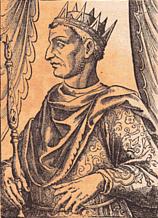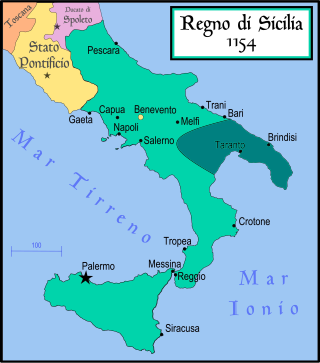Bohemond I of Antioch, also known as Bohemond of Taranto or Bohemond of Hauteville, was the prince of Taranto from 1089 to 1111 and the prince of Antioch from 1098 to 1111. He was a leader of the First Crusade, leading a contingent of Normans on the quest eastward. Knowledgeable about the Byzantine Empire through earlier campaigns with his father, he was the most experienced military leader of the crusade.

Bohemond II was Prince of Taranto from 1111 to 1128 and Prince of Antioch from 1111/1119 to 1130. He was the son of Bohemond I, who in 1108 was forced to submit to the authority of the Byzantine Empire in the Treaty of Devol. Three years later, the infant Bohemond inherited the Principality of Taranto under the guardianship of his mother, Constance of France. The Principality of Antioch was administered by his father's nephew, Tancred, until 1111. Tancred's cousin, Roger of Salerno, managed the principality from 1111 to 1119. After Roger died in the Battle of the Field of Blood, Baldwin II of Jerusalem took over the administration of Antioch. However, he did acknowledge Bohemond's right to personally rule the principality upon reaching the age of majority.

Robert "Guiscard" de Hauteville, sometimes Robert "the Guiscard", was a Norman adventurer remembered for his conquest of southern Italy and Sicily in the 11th century.

Roger I, nicknamed “Roger Bosso” and “Grand Count Roger”, was a Norman nobleman who became the first Grand Count of Sicily from 1071 to 1101.

William I, called the Bad or the Wicked, was the second king of Sicily, ruling from his father's death in 1154 to his own in 1166. He was the fourth son of Roger II and Elvira of Castile.
Tancred of Hauteville was an 11th-century Norman petty lord about whom little is known. He was a minor noble near Coutances in the Cotentin. Tancred is primarily known by the achievements of his twelve sons.

Roger Borsa was the Norman Duke of Apulia and Calabria and effective ruler of southern Italy from 1085 until his death.

The Principality of Taranto was a state in southern Italy created in 1088 for Bohemond I, eldest son of Robert Guiscard, as part of the peace between him and his younger brother Roger Borsa after a dispute over the succession to the Duchy of Apulia.

Drogo of Hauteville was the second Count of Apulia and Calabria (1046–51) in southern Italy. Initially he was only the leader of those Normans in the service of Prince Guaimar IV of Salerno, but after 1047 he was a territorial prince owing fealty directly to the Emperor.
Richard Drengot was the count of Aversa (1049–1078), prince of Capua and duke of Gaeta (1064–1078).

Jordan I, count of Aversa and prince of Capua from 1078 to his death, was the eldest son and successor of Prince Richard I of Capua and Fressenda, a daughter of Tancred of Hauteville and his second wife, also named Fressenda, and the nephew of Robert Guiscard, duke of Apulia, Calabria, and Sicily. He, according to William of Apulia, "equalled in his virtues both the duke and his father."
Grimoald Alferanites was the prince of Bari from 1121 to 1132.
Ranulf II was the count of Alife and Caiazzo, and duke of Apulia. He was a member of the Italo-Norman Drengot family which dominated the Principality of Capua for most of the century between 1050 and 1150. Ranulf's wife, Matilda, was the sister of King Roger II of Sicily.
Tancred of Conversano, the youngest son of Geoffrey, Count of Conversano, became the count of Brindisi on his father's death in 1100.
The Drengots were a Norman family of mercenaries, one of the first to head to Southern Italy to fight in the service of the Lombards. They became the most prominent family after the Hautevilles.

The Italo-Normans, or Siculo-Normans (Siculo-Normanni) when referring to Sicily and Southern Italy, are the Italian-born descendants of the first Norman conquerors to travel to southern Italy in the first half of the eleventh century. While maintaining much of their distinctly Norman piety and customs of war, they were shaped by the diversity of southern Italy, by the cultures and customs of the Greeks, Lombards, and Arabs in Sicily.

The Norman conquest of southern Italy lasted from 999 to 1194, involving many battles and independent conquerors.

The County of Apulia and Calabria, later the Duchy of Apulia and Calabria, was a Norman state founded by William of Hauteville in 1043 composed of the territories of Gargano, Capitanata, Apulia, Vulture, and most of Campania. It became a duchy when Robert Guiscard was raised to the rank of duke by Pope Nicholas II in 1059.
Maud of Apulia was a member of the Norman D’Hauteville family and a daughter of Robert Guiscard and his second wife Sikelgaita, a Lombard princess, the daughter of Guaimar IV, Prince of Salerno. She was also known as Mahalda, Mahault, Mafalda and Matilda. She was the wife of Ramón Berenguer II, and thus Countess of Barcelona (1077–1082). After her husband’s death, she remarried Aimery I, the Viscount of Narbonne (1086–1108).
Fressenda was a Norman noblewoman. She was the wife of Tancred de Hauteville, and the mother of Duke Robert of Apulia and Grand Count Roger of Sicily.













